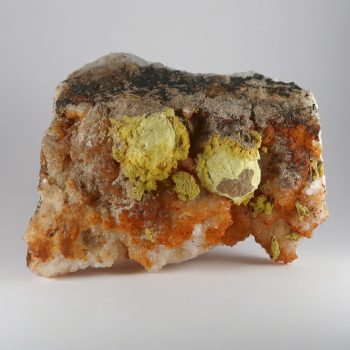Dry Gill Mine
Caldbeck Fell, Cumbria, England, UK
A small former lead mine, famous for specimens of campylite, mimetite, baryte, and, less commonly, plumbogummite.
Some specimens are extremely aesthetic, and Dry Gill Mine specimens are rather well known in the mineral collecting world.
Showing the single result
Cooper & Stanley (1991):
“Of little commercial significance, this mine is one of the most famous mineral localities in the world. Lead minerals consisting predominantly of phosphate-bearing mimetite (campylite) in a gangue of quartz, barite and manganese oxides were deposited in an east-west vein. Other minerals occur rarely, the most well-known being plumbogummite.
Although mimetite specimens from Dry Gill are recorded from at least 1830 there is no record of commercial ore mining here until a lease was taken by Hugh Lee Pattinson, inventor of a cupellation process for the desilvering of lead.
Pattinson began work in 1846, driving an adit on the vein where it crosses Dry Gill beck near the foot of the gill. He raised a few hundred tons of “colored lead ore” but gave up the work in the 1850’s.
The property was subsequently tried by various operators, none of whom had much success. The mine was last worked in 1869.
The finest mimetite specimens were collected in the 19th century but, although increasingly hard to find, some fine material has been obtained since, particularly in the 1970’s.
However, the mine is notoriously unstable, cold and wet, and there have been a number of accidents involving collectors. No one has been critically injured but the incidents have highlighted the dangers of the old workings in the Caldbeck Fells.”
Cooper, M. P., Stanley, C. J. (1990) Minerals of the English Lake District – Caldbeck Fells. The Natural History Museum, London.
Further reading
- https://www.mindat.org/loc-1429.html
- https://geoguide.scottishgeologytrust.org/p/gcr/gcr36/gcr36_drygillmine
If you are interested in other minerals from nearby locales, we may have stock from the following locations.
Cumbria- Arm O'Grain, Mungrisdale, Eden, Cumbria
- Brae Fell Mine, Roughton Gill, Caldbeck, Allerdale, Cumbria
- Brandy Gill Mine, Caldbeck Fells, Cumbria
- Brownley Hill Mine, Nenthead, Alston Moor, Eden, Cumbria
- Burdell Gill, Coombe Height, Caldbeck, Allerdale, Cumbria
- Carrock Mine, Caldbeck Falls, Cumbria
- Deer Hills, Caldbeck, Allerdale, Cumbria
- Driggith Mine, Caldbeck, Allerdale, Cumbria
- Dry Gill Mine, Caldbeck Falls, Cumbria
- Eagle Crag Mine, Patterdale, Eden, Cumbria
- Eskett Quarry, Copeland, Cumbria
- Florence-Ullcoats Mine, Egremont, Cumbria - including the Florence and Ullcoats mines.
- Force Crag Mine, Coledale, Above Derwent, Allerdale, Cumbria
- Goose Green Mine, Frizington, Cumbria
- Haile Moor Mine, Haile, Copeland, Cumbria
- Haltcliffe Copper Smelter, Caldbeck, Cumbria
- Hartley Birkett Mine, Hartley, Eden, Cumbria
- Hartsop Hall Mine, Hartsop, Patterdale, Eden, Cumbria
- Higher Roughton Gill, Roughton Gill, Caldbeck, Allerdale, Cumbria
- Hilton Mine, Scordale, Murton, Eden, Cumbria
- Iron Crag, Roughton Gill, Caldbeck, Allerdale, Cumbria
- Kinniside Mine, Copeland, Cumbria
- Lindal Moor Mine, Lindal & Marton, Barrow-in-Furness, Cumbria
- Mexico Mine, Roughton Gill, Caldbeck, Allerdale, Cumbria
- Middlecleugh Upper Level, Nenthead, Alston Moor, Eden, Cumbria
- Mowbray mine, Frizington, Cumbria
- Old Brandlehow Mine, Keswich, Cumbria
- Old Sandbed Mine, Caldbeck, Allerdale, Cumbria
- Potts Gill Copper Mine, Potts Gill, Caldbeck, Allerdale, Cumbria
- Red Gill Mine, Roughton Gill, Caldbeck, Allerdale, Cumbria
- Roughton Gill Mine, Caldbeck Falls, Cumbria
- Saddleback Old Mine, Mungrisdale, Eden, Cumbria
- Sandbeds Gill Mine, Bassenthwaite, Allerdale, Cumbria
- Shap Pink Quarry, Shap Rural, Eden, Cumbria
- Short Grain, Deer Hills, Caldbeck, Allerdale, Cumbria
- Silver Gill, Roughton Gill, Caldbeck, Allerdale, Cumbria
- Stockhow Quarry, Kirkland, Lamplugh, Copeland, Cumbria
- Stoneycroft Smelter slag locality, Above Derwent, Allerdale, Cumbria
- Smallcleugh mine, Nenthead, Alston, Cumbria
- Tynebottom Mine, Garrigill, Alston Moor, Eden, Cumbria
- Wad Mine, Seathwaite, Borrowdale, Allerdale, Cumbria
- Wet Swine Gill, Coombe Height, Caldbeck, Allerdale, Cumbria
- Wythburn Mine, St. John's Castlerigg and Wythburn, Allerdale, Cumbria
You can also browse by county: • Cheshire • Cornwall • County Durham • Cumbria • Derbyshire • Devon • Dorset • Gloucestershire • Kent • Lancashire • Leicestershire • Merseyside • Norfolk • North Somerset • North Yorkshire • Northumberland • Shropshire • Somerset • Staffordshire • Surrey • West Midlands • West Sussex •
For the rest of our UK stock, see below.
United Kingdom
Fossils from the United Kingdom - Minerals from the United Kingdom

